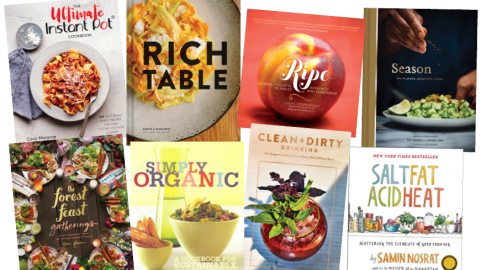A Taste of: Salt, Fat, Acid, Heat by Samin Nosrat
Part cookbook, part master class, this illustrated resource by the celebrated Bay Area chef transforms home cooking by adding and layering the core elements of good taste.
From Salt, Fat, Acid, Heat: Mastering the Elements of Good Cooking by Samin Nosrat. Copyright © 2017 by Samin Nosrat. Reprinted by permission of Simon & Schuster, Inc. Buy this book.
If you’re a little tired of your old tried and true recipes, here’s an antidote: Samin Nosrat’s book Salt, Fat, Acid, Heat will leave even lifelong cooks wondering how they ever approached a chicken without it.
A New York Times bestseller, winner of a 2018 James Beard Award and subject of a Netflix series debuting this October, Salt, Fat, Acid, Heat is much more than a cookbook. It’s a cooking lesson come to life, explaining why foods are transformed by these four elements and how to take charge of that process. Sound too esoteric? The opposite is true. Salt, Fat, Acid, Heat builds on everyday cooking experiences and explores some common sense behind the outcomes.
The idea for the book occurred while Samin was finding her feet at Chez Panisse, where she got her start at the age of 20. In an interview with The Gannet, Samin explained, “I was bewildered how these people knew how to cook everything without ever consulting a recipe. Over the course of a year or more, I started to see this pattern. No matter what we’re doing, we’re always salting the meat the day before, we’re always heating the pan before we add oil, on the pastry side we keep the butter cold so we get flaky pastry, and we’re always adding and adjusting acid.” This led to her aha! moment that all good cooking depends on the considered application of salt, fat, acid and heat.
The book offers an uncomplicated way to ensure a dish is successful: Is there enough salt? How is fat used to infuse flavor or impact the texture? Is there enough acid to balance the overall flavor? The same goes for heat. Understanding the purpose of each—that’s where cooks become chefs and results become predictable.
Samin also covers uncommonly discussed topics, such as the significance of knife cuts, emulsions and the variables that impact doughs and batters. If it sounds like an encyclopedia, it doesn’t read like one: Playful hand-drawn visuals by Bay Area artist Wendy MacNaughton and Nosrat’s real-world anecdotes make it a page-turner.
The recipes don’t start until halfway through the book but it’s worth the wait. The “Salad Axis” offers pairings of ingredients and dressings that read like the menu of the restaurant you wish was on the corner. Most of the recipes are “base” versions with variations—meaning you master one recipe and get several options to mix it up in the future.
It’s clearly how chefs think—this fundamental understanding of how to treat ingredients, and how to mix and match flavors and textures that sparks creativity, and turns simple ingredients into memorable dishes. With chapters including, “Thirteen Ways of Looking at a Chicken” and hand-drawn diagrams titled ”Aromatic Flavor Bases of the World,” you can see the breadth of Samin’s experience and her unique way of looking at everyday, locally inspired foods.
Since leaving Chez Panisse and while writing Salt, Fat, Acid, Heat , Nosrat also became chef mentor to Michael Pollan (author of Omnivore’s Dilemma and creator of the Netflix Cooked series). She now writes for the New York Times, cooks and teaches, as she spreads her beliefs and knowledge about the importance of cooking well.
Click Images : to view larger version.



